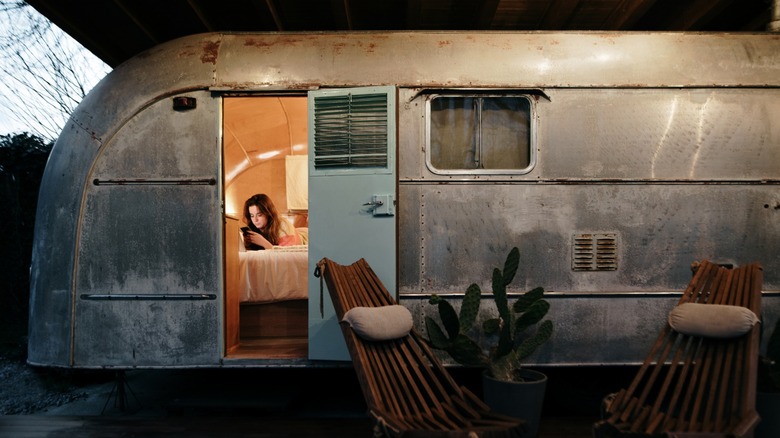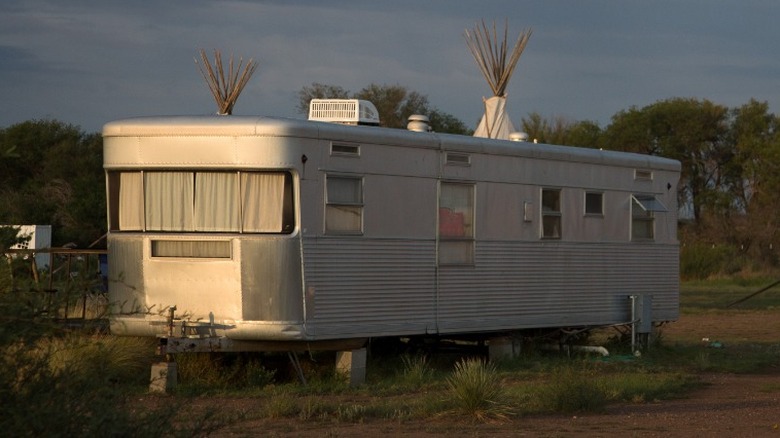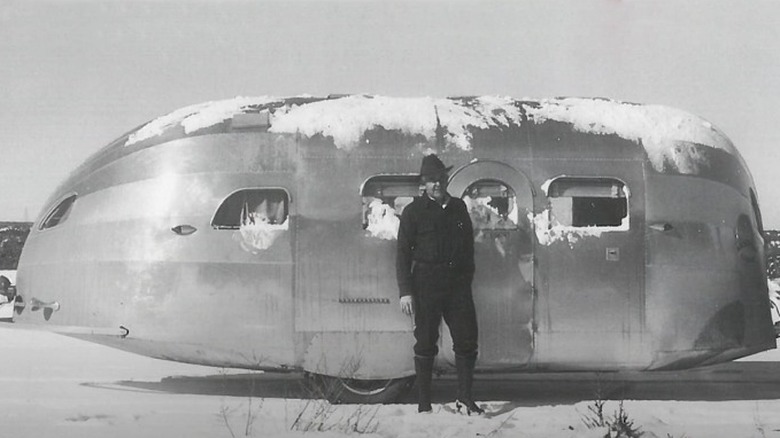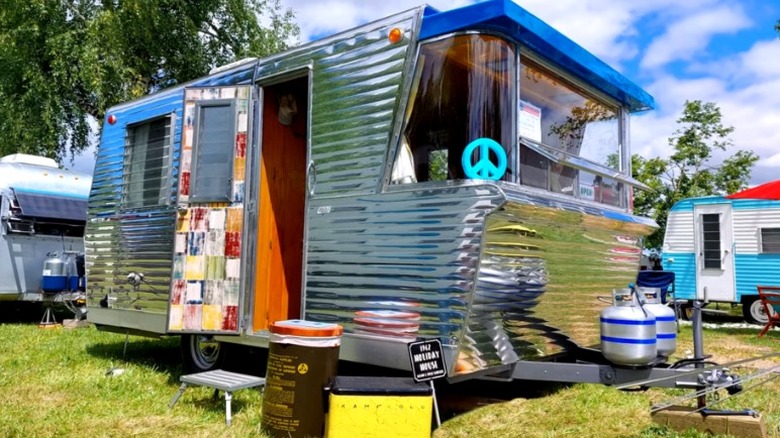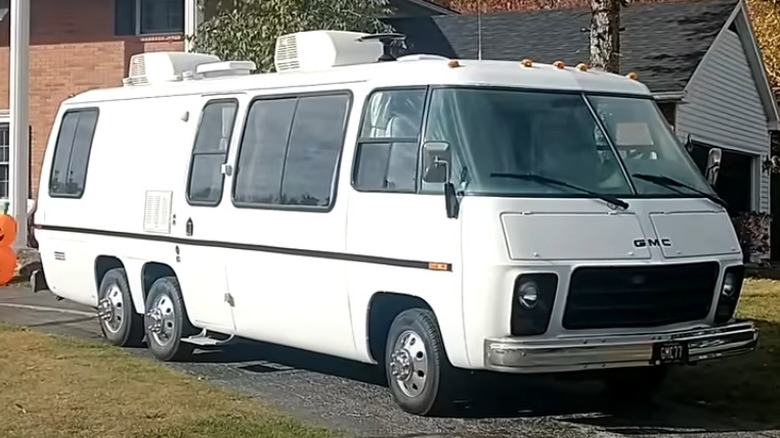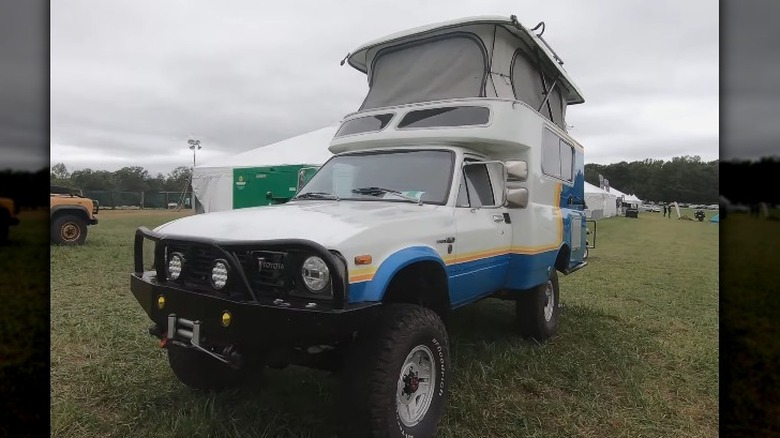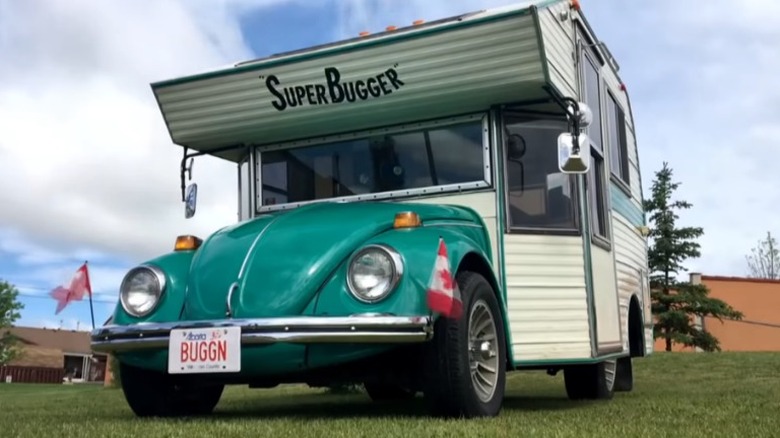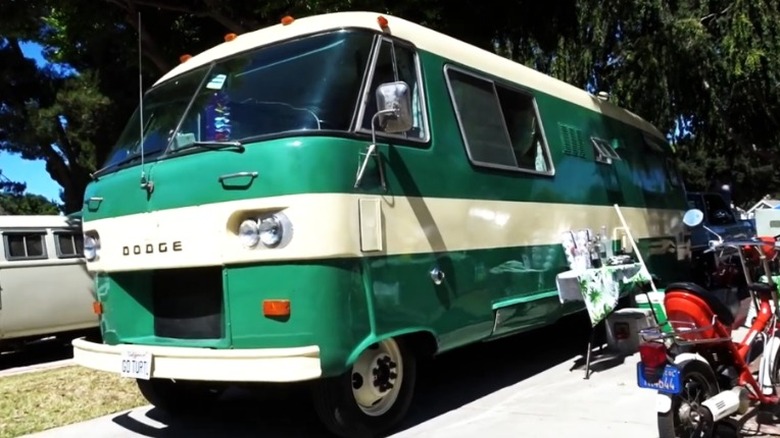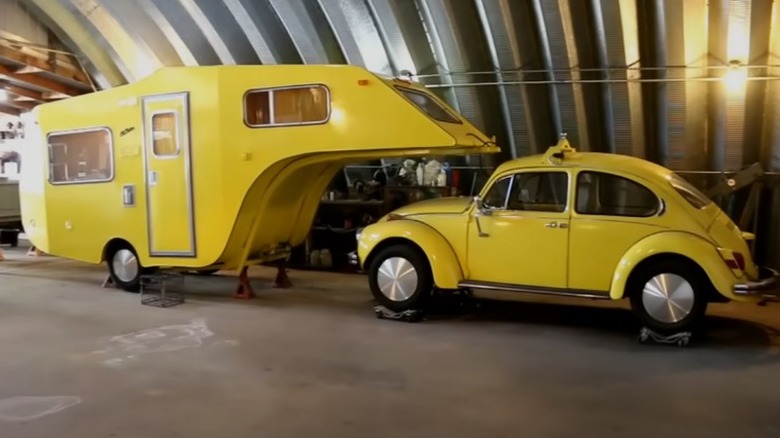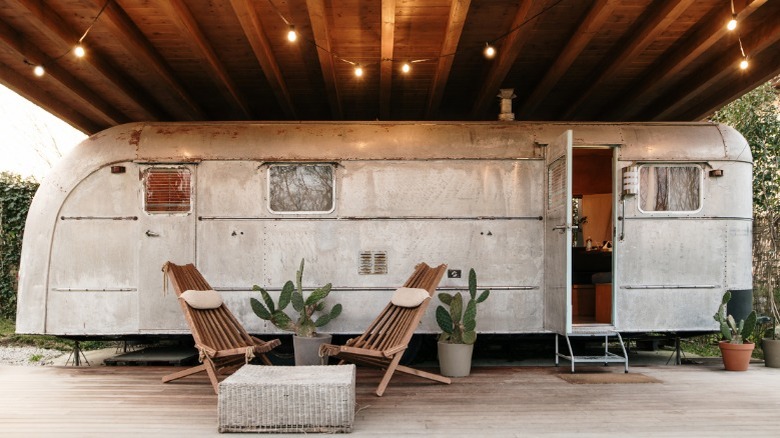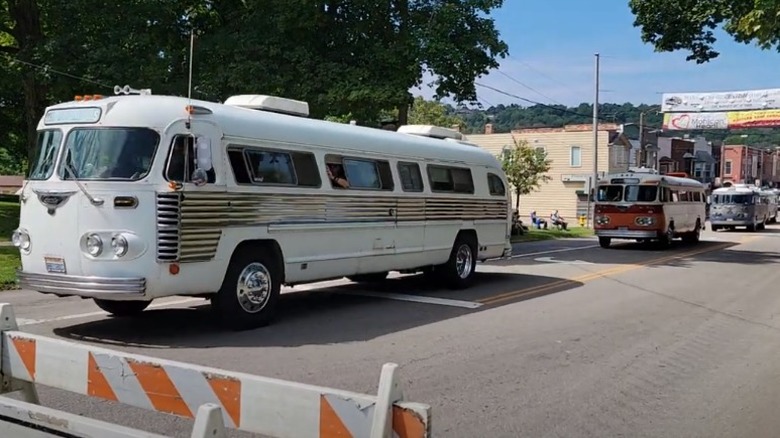10 Coolest Retro RV Campers Ever Made
RV campers are an indelible part of American road trip culture. They are a symbol of the freedom of the open road, offering the ability to get out and see the world while retaining the familiar creature comforts of home. The option to take off into the wilderness or traverse the American West while having a guaranteed place to sleep every night is alluring and scores of businesses have sprouted up to cater to these travelers offering everything from places to park to retail establishments offering all the supplies you could think of.
The history of RV campers largely runs parallel to automobile development. Prior to the invention of the internal combustion engine, wagons were used to traverse long distances, often with everything the family owns in tow. It should then come as no surprise that the old Conestoga wagon would evolve into the Winnebago of today. Defining RV is a bit subjective, but the broadest application of the word generally covers a temporary and mobile dwelling designed for recreational purposes. And in the last century or more of RV camper development, a vast array of styles, sizes, and configurations of campers has evolved to fulfill the needs of anyone, no matter how quirky and exotic their demands may be. Excluding the countless singular custom campers and concentrating solely on those manufactured for sale to the public, these are 10 of the coolest RV campers ever made.
Spartan Imperial Mansion
Spartan Aircraft was a manufacturer in Tulsa, Oklahoma that contributed significantly to the war effort during WWII. After the war, the company needed a way to use all of its excess manufacturing infrastructure and chose to apply it to the growing camper industry. With the expertise gained from producing aluminum-bodied aircraft, Spartan rolled shiny aluminum travel trailers out the door.
While the Imperial Mansion is a 47-foot travel trailer, these were also used as permanent dwellings as a precursor to the modern manufactured home. They are clad with aluminum all over and feature wood veneer paneling inside with a large picture window looking out the front. The streamlined look of the Spartan with curves in the aluminum construction gave a unique look but was also far ahead of the competition of the time, which were poorly constructed rolling boxes.
Many Spartan trailers have been ravaged by time and weather, but many still survive thanks to the anti-rust properties of the aluminum construction. Today, nicely restored Spartans are highly popular for their mid-century streamlined look. They can be found for rent around the country, such as a 1956 model located on the grounds of a drive-in movie theater in Oklahoma. Values have also increased to the point that Sotheby's recently sold an excellent 1959 model for $78,000, significantly more than its original $6,982 price tag.
Airstream Clipper
With the serial production of the Airstream Clipper beginning in 1936, an icon was born. The man behind the Airstream started building trailers of wood and Masonite as well as offering plans for DIY trailers. After realizing some success with this, he came up with plans to build one out of aluminum panels riveted together for a high level of strength and rigidity. The first of these shiny and innovative campers became the blueprint for one of the most unique campers on the market.
From the start, the Clipper was built for high-end customers and offered a level of luxury exceeding the competition. Trailers were lined with wood paneling laid over aviation insulation and included all the amenities of home, including accommodations for four, a kitchen, and a bathroom, although it was only equipped with a commode as a workable toilet design would come along later. The Clipper also held its own water supply and boasted of cedar closets as well as a ventilation system that incorporated a dry-ice air conditioner, an original idea of the Airstream. With the premium features came superb build quality but also a price to match. When they were new Airstream Clipper prices more than doubled that of a new Ford sedan.
Holiday House
For a couple of years in the early '60s, smaller campers called Holiday House were made and they are clearly designed as a product of the atomic age. The original models started with 17-, 19-, and 24-foot trailers and expanded the shortest models to 18 and 20 feet in 1962. They are attractive lightweight campers clad with shiny aluminum exterior trim accented with pastel colors such as turquoise or peach and a large wrap-around window up front providing expansive views of whatever campground or scenic vista you park it on. Inside you will find formica countertops trimmed on the edge with aluminum strips like old-time diner counters, and furniture featuring design accents distinctive to the early '60s.
Holiday House only made these trailers for a couple of years and closed up shop after the 1962 models were gone. The company name bounced around for many years through several owners, but nothing ever came from it. However, in 2014, the Holiday House name was resurrected by a company that started building new trailers under the old name. Only it did not just use the name, it started making recreations of the old trailers with faithful reproductions. The interiors are much more modern and feature the latest equipment, but, from the outside, they are hard to tell apart.
GMC Motorhome
GM only got into manufacturing motorhomes once, but it had a good run. Its motorhome was built by the GMC division and included some innovative features that could have only come from a GM division. The most clever design idea was the use of the engine and transmission from the Oldsmobile Toronado which was a big block 455-cubic-inch engine with front-wheel-drive transmission. This allowed GMC to drive the front wheel of the motorhome and keep the floor extremely low without needing room for a driveshaft. This gave the interior excellent headroom and made it feel much more spacious than other motorhomes of the era.
Outside, the GMC looked a bit like something from a space movie with its aerodynamic fiberglass body. In the rear are two sets of wheels on tandem axles and a hydro-air spring, driven by the power steering pump, provides the frame's suspension and results in a smooth ride. GMC produced 12,921 copies from 1973 to 1978, which makes them somewhat rare today, but not unobtainable. They continue to have a dedicated following and custom versions are enjoyed all over the place with die-hard owners keeping them on the road more than 50 years after they left the factory.
Toyota Chinook
Founded in 1938, Chinook manufactured small campers for many years until developing fiberglass shells for RVs in the '60s. With the fuel crisis of the '70s, Chinook turned to Toyota for a robust chassis on which to build an economical RV. From 1973 until 1979, Chinook made a weekender-style camper on an imported half-ton chassis known as the Toyota Chinook.
The Toyota truck, aka Hilux, is legendary for being a tough and reliable vehicle capable of carrying much more than one might expect, an excellent base for a camper. The Chinooks were smaller rigs made for only a couple of people — room for small children could be accommodated — and offered only basic amenities. A typical Chinook slept two and provided a small kitchen with a stove, sink, and a small icebox. To keep it compact and manageable on the road, the entire roof popped up, revealing a canvas liner extending the walls to provide room to stand up. Chinook could achieve up to 29 mpg highway mileage and 16 in town, figures competitive with modern RVs.
Production ended around 1980 as Toyota chose to leave the chassis business to take on the light truck market. Chinook diversified into conversion vans among other products and is still around. But the old Toyotas are extremely popular and have a loyal following of people customizing, restoring, and maintaining these unique little homes on wheels. A restored and upgraded example sold recently on Bring a Trailer for $49,000.
Super Bugger
While some may think even a Toyota truck is too small to carry the weight of a full camper, they may be seriously surprised by the Super Bugger. This vehicle is a fully functional basic camper that was offered as a fully functional conversion or could be ordered as a DIY kit. The original advertisements claim that the plans could convert any 1961 to 1977 VW into a camper in about 60 hours.
The most obvious element of the Super Bugger is that it is unendingly cute, but also seemingly improbable. Air-cooled VW engine output peaked at 60 horsepower with the 1600cc variant, which sounds absurdly low for hauling your own hotel room down the highway. Yet, somehow it worked. The camper replaced everything from the a-pillars back, replacing even the windshield, and the camper doors became the only doors to the vehicle. Inside is a snug arrangement with a dining area for two that converts into a bed, a tiny kitchen area with a gas cooker, a bit of storage, and a sink.
While this will never be the choice for any extreme expedition, it would certainly work for a weekend at the lake. Furthermore, no matter where you go with one, you will never want for conversation as everyone will flock to this adorable curiosity.
Dodge Frank Motor Home
Mid-century design is one of the most popular styles of industrial design today, with items from the '50s and '60s being highly sought-after as well as modern products being styled with a similar aesthetic. This popularity applies to motorhomes as well, and the Dodge Motor Home is the epitome of mid-century design. Spawned from a prototype called the Frank Motor Home, this home on wheels is the first vehicle purpose-built to be a home on wheels rather than a modified truck, and a partnership with Chrysler led to them being marketed as a Dodge. Furthermore, the builder of these vehicles also coined the word Motorhome, although a space is included in the official name.
The body is made of fiberglass, and that gave the builder freedom to update the design rapidly as orders grew from the first models in 1961 and lasted into the 1970s under the Travco brand. Inside you can find a three-burner range with an oven, sink with running water, ample storage, and accommodations for four. Being the predecessor to the modern motorhome, the Motor Home came equipped with an on-board generator, roof-mounted air conditioner, and enclosed bathroom with shower and toilet, and it was powered by a Dodge V8 engine providing plenty of power for a cross-country journey in style.
The curves and angles of the Dodge Motor Home make it a gem in a campground of modern campers, especially when restored featuring the subdued pastels of the era and period-correct furnishings.
El Chico
While the Super Bugger proves a VW can haul camping accommodations for two, the El Chico trailer ups the ante a bit. Much like the Harmon trailer pulled from the roof of large American cars, the El Chico mounts to the roof of a Beetle to be hauled along by the (hopefully) 1600cc 4-cylinder. This one came from the 1970s and is a gooseneck-style camper that could probably be pulled from many small cars of the time, but in existing promotional videos, they chose the Beetle.
For a small camper light enough to be pulled by a compact car, it's surprisingly roomy and well-appointed. Inside is a bed for two in the gooseneck forward area with a sink and two-burner detachable stove and sink just below. There is also a camper-sized refrigerator and an enclosed bathroom with a shower. In the rear is a dining table that converts into a full-size bed to round things out. The whole thing uses clever packaging to fit so much in a small space, and with the tow point on the roof, the total length of the car and trailer is surprisingly short.
In the original promotional video, the El Chico is demonstrated showing its versatility as a trailer. With the roof mount on a short car, the driver can pull, turn, and back up the trailer in a 360-degree motion with the ability to park the trailer in a spot by having the car turned around and pushing the trailer back.
Vagabond
Manufacturing of Vagabond trailers began early in the Depression with the first models being constructed of flimsy and subpar materials much like many others at the time. However, things changed in 1936 when the trailers were upgraded to aluminum construction on top of a steel cage frame welded to the chassis for a durable and rigid trailer. The company was contracted to build temporary housing for the war effort in 1941, returning to leisure trailers afterward, when it created some of its most attractive and iconic trailers that are now considered a most attractive retro style.
The aluminum exterior construction allowed Vagabonds to adopt the curved corners that prevent them from looking like nothing more than a box on wheels and give them a distinctive look. Interiors were well-equipped for the time with modern amenities including a kitchen with a gas range, electric refrigerator, and a heater. The quality of Vagabond was extremely high, showing from the birch cabinetry and wall paneling as well as floors made from ¾-inch plywood with linoleum coverings. They competed directly with Spartan for the high-end business of travel trailers throughout the 1950s. However, Vagabond was later bought by a manufacturer of mobile homes and transitioned Vagabond trailers to "park models" that were up to 57' and intended more for permanent living than recreational travel.
Flxible Starliner Land Cruiser
For anyone with an interest in owning a vintage RV, the Flxible Starliner Land Cruiser is the ultimate mid-century road home. It comes from a company building buses since the 1920s that was responsible for many mass transit solutions in the first half of the 20th century. The name comes from a flexible sidecar mount first produced by the company and the "e" was removed to make it eligible for trademark. In the mid-'50s, Flxible released its Starliner motor coach with a Land Cruiser model conversion as a motorhome.
Flxible coaches were popular choices for touring artists back in the day, including blues guitarist B.B. King. Just as large motor coaches today are hundreds of thousands of dollars, these were very expensive. Today, the limited number remaining can be found in various conditional states, with many having been restored or renovated in resto-mod fashion, using the highlights of the design with modern amenities and drivetrain. Resto-mod Starliners are the best of both worlds but expect to pay handsomely to have an up-to-date motorhome with mid-century style.
To have the pleasure of cruising the country in one of these amazing machines, but without the absolute headache of building it yourself, you will first have to find one. Finding one of the limited inventory available for sale is a feat unto itself, but then you will need at least $150,000 just to walk through the door. But if you do, you will look like a million bucks.
